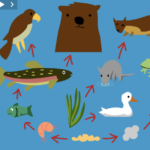Food Chains Lesson Plan: Interactions, Energy, and Dynamics
*Click to open and customize your own copy of the Food Chains Lesson Plan.
This lesson accompanies the BrainPOP topic Food Chains, and supports the standard of developing a model to describe the movement of matter among plants, animals, decomposers, and the environment. Students demonstrate understanding through a variety of projects.
Step 1: ACTIVATE PRIOR KNOWLEDGE
Display an image of a food chain, like this one from the BrainPOP Food Chains movie:
Ask students:
- How are these organisms connected?
- What might the arrows connecting the organisms represent?
Step 2: BUILD KNOWLEDGE
- Read the description on the Food Chains topic page.
- Play the Movie, pausing to check for understanding.
- Have students read one of the following Related Reading articles: “Yuck,” “Real Life,” or “Mother Nature.” Partner them with someone who read a different article to share what they learned with each other.
Step 3: APPLY and ASSESS
Students take the Food Chains Challenge and Quiz, applying essential literacy skills while demonstrating what they learned about this topic.
Step 4: EXTEND and DEEPEN
Students express what they learned about food chains while practicing essential literacy skills with one or more of the following activities. Differentiate by assigning ones that meet individual student needs.
- Make-a-Movie: Produce a news report about an ecosystem where a producer’s population has decreased suddenly. In your report, answer this question: What impact does this have on food chains across the ecosystem?
- Make-a-Map: Identify the movement of energy through a specific food chain. Identify producers, consumers, and decomposers involved.
- Creative Coding: Code a game where players determine whether an organism is a producer, primary consumer, secondary consumer, or decomposer.
More to Explore
Food Fight Game: Students apply understanding of ecosystems by creating food webs that increase species’ population.
Teacher Support Resources:
- Pause Point Overview: Video tutorial showing how Pause Points actively engage students to stop, think, and express ideas.
- Learning Activities Modifications: Strategies to meet ELL and other instructional and student needs.
- Learning Activities Support: Resources for best practices using BrainPOP.












